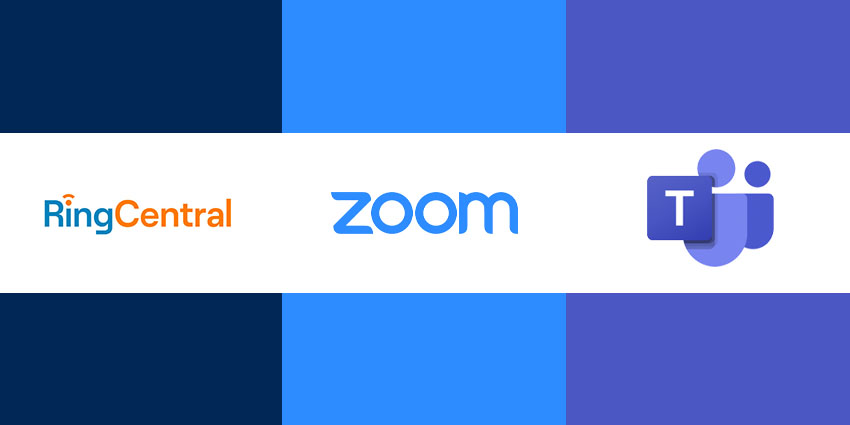In a world defined by remote and hybrid working patterns, companies are rapidly replacing the “physical” office with the virtual workplace. Tools like Zoom, Microsoft Teams, and RingCentral MVP provide organisations with a central hub where distributed employees can interact.
Zoom, Microsoft Teams, and RingCentral all offer companies a selection of critical tools for productivity and communication. Within these environments, teams can share files, links, and screens, communicate over instant chat, audio, or video, and even schedule conversations via synced calendars.
The challenge for today’s team leaders is choosing the right service to ensure success. Today, we’re going to compare some of the most important features of RingCentral, Zoom, and Microsoft Teams to help you make the right decision.
RingCentral vs Zoom vs Teams: Features
RingCentral, Zoom, and Microsoft Teams have a lot of overlap between features. All three providers will offer a secure and reliable way to communicate and collaborate in the digital world. You can connect with peers through video conferencing, group messaging, file sharing, and chat. There’s also access to business telephony through Microsoft Teams Business Phone or direct routing, RingCentral calling plans, or Zoom Phone.
Let’s look at a few of the feature options head-to-head
| Features | Microsoft Teams | Zoom | RingCentral |
| Video conferencing | Yes | Yes | Yes |
| Content sharing | File sharing, to-do lists, @mentions, pinned messages, and SharePoint integrations. | File-sharing and document sharing in meetings. Third-party integrations with content sharing tools. | Document management, file sharing, and screen sharing functionality. |
| Telephony | Yes, via direct routing or Business Phone packages | Yes | Yes |
| Integrations | Extensive integration with Microsoft tools and third-party apps. | Zoom apps and hundreds of available integrations. | Integrations with over 180 different third-party apps. |
| Voice quality | Voice calling available through Microsoft Teams and direct routing for excellent calling | Audio meetings and calling through Zoom or integrations with third-party providers. | Excellent global RingCentral network with 99.999% guaranteed uptime. |
| Ease of use | Convenient and easy-to-use interface with quick search functionality and shortcuts on all devices. | Simple and accessible app interface with access through all devices. | Easy-to-use backend with exceptional support and guidance from RingCentral. |
| Security | SSO, SAML, and other account control options. Multi-factor authentication, HIPAA compliance, EU privacy clause compliant, and SOC 1 and SOC 2 guidelines. Password protections available. | SAML and full account control. AES 256-bit encryption to protect data. HIPAA, GDPR, and other compliance standards. Password protection for meetings. | Extensive AICPA SOC 2 and SOC 3 compliance, HIPAA ready, and equipped with various cross-industry, international certifications. |
| Pricing plans | Both free and paid options available. | Both free and paid options are available. | Both free and paid options are available. |
RingCentral vs Zoom vs Teams: Features
Despite the rise of various new communication methods over the years, voice continues to be a crucial component of any UCaaS investment. All three of our competitors in this comparison offer voice through audio conferencing and telephony.
Microsoft offers a wide range of telephony options through either Microsoft Business Calling plans, Microsoft Direct Routing, and Operator Connect. Zoom offers Zoom Phone for IP calling, and you can port your own numbers into the system to ensure you don’t have to build your identity from scratch. RingCentral provides both inbound and outbound calling with access to advanced features like IVR, ACD, and custom voicemail.
As a communication leader first-and-foremost, RingCentral is definitely more voice-focused than Teams and Zoom, with 99.999% uptime guarantees an amazing global reach.
RingCentral vs. Zoom vs. Teams: Video Meetings & Teamwork
Enabling collaboration in Teams, RingCentral and Zoom couldn’t be simpler. All three tools are committed to bringing staff together in a remote or hybrid environment.
Microsoft Teams offers instant chat, file sharing and screen sharing, access to shared calendars for planning meetings, and integrations with a range of productivity management tools. Microsoft also offers a range of features in the “Viva” toolkit, excellent for tracking performance and examining employee engagement. Video meetings are extremely immersive, with Together mode, virtual backgrounds, and a range of presentation options.
Zoom takes a video-first approach to collaboration, enabling quick and easy meetings at the touch of a button. Users don’t even need a Zoom account to join a discussion. Within meetings, teams can share files and screens, create breakout rooms, and change their backgrounds. You can access a range of speaker views, including something similar to the Together mode from Microsoft Teams. Zoom also makes it easy to host webinars and events.
RingCentral MVP facilitates all kinds of collaboration through audio and video calling, messaging, screen sharing, and file sharing. You can easily flip calls and transform them into video meetings at the touch of a button. RingCentral also integrates with Google Drive to help you quickly upload and share all kinds of documents and spreadsheets.
All three providers offer hardware solutions and dedicated meeting room technology to make your collaboration sessions even more incredible.
RingCentral vs Zoom vs Teams: Security and Integrations
Security should always be a top consideration when choosing a UCaaS and collaboration tool. Fortunately, RingCentral, Zoom, and Teams have all got you covered. All three services offer extensive end-to-end encryption for your communication data. You can expect compliance with guidelines like HIPAA and GDPR, as well as exceptional control over account settings for each of your employees, so you choose who can do what.
All three tools also give you access to reporting and analytics tools so that you can gain insights not just into employee productivity but compliance too.
On top of that, Microsoft Teams, Zoom, and RingCentral all have a host of integrations available to take your UCaaS system to the next level. Zoom and Microsoft both have their own app marketplace, as well as dedicated partnerships with leading companies like Salesforce and Slack. RingCentral integrates with more than 180 third-party apps, including HubSpot, Salesforce, and many others.
RingCentral vs Zoom vs Teams: Which is Best?
Choosing the best UCaaS solution from RingCentral, Microsoft Teams and Zoom can be tough. All of these solutions have a lot of overlap in their feature offerings. If you’re looking for video conferencing, telephony, and chat in one secure environment, Microsoft, Zoom, and RingCentral will all deliver. However, there are some differences to consider too.
Microsoft Teams makes sense as your go-to collaboration and communication tool if you already have a lot of investment in Microsoft tools and productivity apps. The integrations with the Microsoft ecosystem are excellent.
Zoom is a great pick for video-first companies who want to access quick and convenient video meetings and webinars in seconds. Zoom also has deep integrations with other vendors like Five9 for contact centre and UCaaS functionality.
RingCentral MVP is the go-to choice for companies looking for exceptional call quality and global reliability. You get an amazing phone service from RingCentral for both inbound and outbound calls, and can easily combine your UCaaS and CCaaS stacks.







